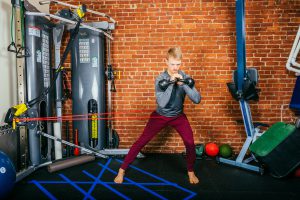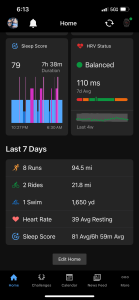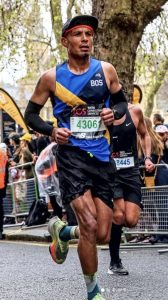 Rob Stephenson, personal trainer and co-founder of Om Train at Om Namo Center, has some thoughts on how you can improve your health. It’s not all about muscular strength!
Rob Stephenson, personal trainer and co-founder of Om Train at Om Namo Center, has some thoughts on how you can improve your health. It’s not all about muscular strength!
21st Century: Aging Us Faster
There are several deteriorations that occur in our body as we get older. The two main ones are bone demineralization and muscle or fascial dehydration. Bones become brittle and muscles develop stiffness. This leads to all sorts of soft tissue injuries including arthritis, tendonitis, muscle tears or strains, bone breaks or fractures, spasms, nerve damage, and it is a slippery slope from there.
“As we get older” doesn’t mean being 50 or 60 anymore. ‘Older’ used to be when you approached the ripe age of 30, but with our lackadaisical lifestyles today, I see young people getting ‘older’ by 25. What I mean to say is that muscle dormancy begins kicking in, and posture is falling apart (not literally, though figuratively). So we’re all in this time warp together no matter your age or current condition. We can all agree that optimizing human characteristics has got to be a priority in today’s world. And unless we choose to do something about it very little will change.
If you want to know anything about injuries know this; most of them happen outside of a ‘fitness’ setting- that is to say in the world, when performing daily tasks. And secondly- from repetitive motion without variation or biomechanics implemented. This is because we tend to do in the world without regard to our posture or alignment. And exercise typically (over time) drives unhealthy, unnatural patterns deeper into the body- imposing locked musculoskeletal patterns into the soft tissue.
Do you really think you can outsmart gravity, lifestyle, and old habits?
Quick Rant…
Why am I telling you this? Because if we have any interest in developing a sustainable movement program, we have got to understand why we do what we do. It is crucial to train intentionally and not habitually. Time will prove to us over and over again that the body will choose the path of least resistance…and so will your mind. So if you are given the choice of fitness classes, or going running without understanding gait, or doing yoga without having a clue about myofascial force transmission, typically you’ll choose one of these options. It is easier, it is the path of lesser resistance. On the other side of the coin you have one-on-one training which can be more educational and teaches you the biomechanal principles of your movement, though this takes more effort and brain power (and obviously money, but if you’re arguing cost over long-term health I’m not the guy for you). It forces you to look at where you actually are and cognitively-process your proprioception by feeling your body’s positioning. This is harder because you, like your body, doesn’t want to listen to reason- you just want to “workout”.
Gyms have become the quick fix you experience at the doctor. We treat ourselves and our bodies like a number, something we don’t want to put a lot of necessary work into, but we still demand results. We tend to hold our bodies so close to ourselves, we tend to think we know best, and this type of thinking ends up getting in our way of real progress, real success, and real change. Rant Over.
Training Your Bones Like Muscles
Let’s talk training bone density. So bones respond much like muscle, in the sense that you want to load your bones with weight or resistance to better ‘densify’ them. Have joint pain? Chances are your muscle system aint working the way nature intended it to. However, if you have strong bones, they will feed your muscles that more efficiently. Then your muscles will repay your bones by supporting them and helping them function with more ease and precision. It just so happens that adulthood is one of the best times to start training your bone health and bone longevity. Especially if you want to stay doing what you love well into your senior years.
The most effective way to train for these effects? Besides using heavy weights to stimulate bone growth you want to challenge the bones and joints to work in all of their ranges of motion (arthrokinematics enters the room). Remember- nature made you the way you are because it intended the body to be used in a multitude of scenarios; reactive / dynamic ones, static ones, and restful ones. You’ve got to think about how the human condition and body evolved- it was made to be used with conscious attention. So the idea behind training should be to take unconscious tissues and make them conscious, eventually training them to work subconsciously.
For bone stimulation the best movements involve multi-planar exercises that require the individual to change directions, leap, and bounce from place to place while still in control. You want to use weights and resistance whenever possible to challenge the nervous system and to put your fascial chain systems to work (ergo; we can train elasticity). The idea is to develop a program that constantly evolves and to then sustain it for a lifetime. However, in my experience people try to do a lot of the agility, jumping, and dynamic work way too early, before adequate potentiation and understanding of muscle chains have been honed in on.
Go Slow: Train Intrinsic Muscle Chains First
Without training proper intrinsic stability and strength first, going into the ballistic and multi-planar training could be detrimental to your bone health. You’ve got to be able to sustain and understand sagittal plane movement, as well as functional core engagement before taking on the next levels. Deep internal control has to be felt and built up if you wish to use the extrinsic muscle chains to create movement. Otherwise you’re skipping steps (and one day you’ll regret this). I’m telling you- train your alignment, have competency in that before taking on the more advanced exercises. The path to self-sustainability and functionality is not a fancy one. You have got to work at it- and then you get to do whatever you want pain-free and with connection in your body.
Studies show us time and time again that any exercise can help improve fitness, but not necessarily bone density or health. Repetitive movements, from circuit training, to walking and running, to weightlifting can actually reverse the process. It can lead to joint inflammation, muscle inhibition, and eventually injury. My suggestion is to not grow stagnant in your training and to keep your focus on strengthening your joints and lengthening your spine. A longer spine (with proper engagement through muscle chains) will help facilitate better functioning joints, and joints with improved osteokinematics will create improved circulation to the bones at the joint site. If circulation improves, you can better feed your muscles. If you can better feed your muscles, then you can start to potentiate lines of myofascial force transmission and understand how to train and unify with gravity. Because after all- gravity is a longitudinal force vector that will push you around to whatever degree your body chooses to allow it.
I hope this encourages you to think about what it is you’re doing for your body, health, and physical training. I also hope it sparks interest from you to reach out and change the game- be a player in your body, not a sideline sitter. Knowing is one thing, doing is a whole different part of the game.
– Rob Stephenson



